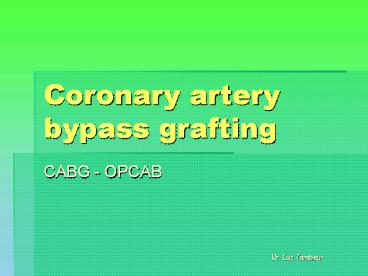Coronary%20artery%20bypass%20grafting - PowerPoint PPT Presentation
Title: Coronary%20artery%20bypass%20grafting
1
Coronary artery bypass grafting
- CABG - OPCAB
2
Coronary artery disease
- Definition
- Narrowing of the coronary arteries
- Caused by thickening and loss of elasticity of
the arterial walls - Limiting blood flow to the myocardium
- Flow reserve (effort)
- At rest
- Occlusion
3
Coronary artery disease
- Morphology and processes
- Focal intimal accumulation of lipids, blood
elements, fibrous tissue, calcium etc. with
associated changes in the media - ? Plaque
- ? Stenosis
- Regression of plaque and collateral formation
- Plaque rupture and thrombosis
- Usually affects multiple coronaries
simultaneously, proximally and at bifurcations
4
(No Transcript)
5
(No Transcript)
6
(No Transcript)
7
(No Transcript)
8
Myocardial infarction
- Imbalance between oxygen supply and demand
- Myocardial necrosis starts after 20 minutes
- Border zone
- Reperfusion within 3-4 hours can limit the extent
of myocardial necrosis - Scarring. LV systolic and diastolic dysfunction.
Chronic heart failure.
9
(No Transcript)
10
(No Transcript)
11
Diagnosis
- Symptoms Angina pectoris, acute myocardial
infarction, chronic heart failure, sudden death,
incidental finding on ECG - Noninvasive tests to identify and quantify CAD
and sequelae ECG, CXR, Labs, Exercise testing,
Nuclear scans, Echocardiography, CT (Ca)
12
Diagnosis
- Associated conditions
- Atherosclerosis carotids, PAD
- Definitive diagnosis extent, distribution and
severity of anatomic coronary artery disease - Coronary angiography
- New modalities CT (MRI)
13
Coronary angiography
- Grading of stenoses
- Moderate 50 diameter 75 cross-sectional area
loss - Severe 67 diameter 90 cross-sectional area
loss - Distribution
- Single system / two system / three system
- Left main
14
(No Transcript)
15
(No Transcript)
16
Coronary anatomy
17
(No Transcript)
18
(No Transcript)
19
(No Transcript)
20
(No Transcript)
21
(No Transcript)
22
Indications for surgery
- Comparative benefit of surgery relative to no
treatment / medical treatment / PCI - Enormous variability in CAD, impacting on risk
calculation ? patient-specific predictions - General indications
- Left main or left main equivalent
- 3 system disease
- 2 system disease with severe prox. LAD and LVEF lt
50 or ischemia on non-invasive testing - 1 or 2 system disease with large area of viable
myocardium and high-risk criteria
23
(No Transcript)
24
Bypass grafting
- Full sternotomy and CPB (HLM)
- CABG
- Full sternotomy, no CPB
- OPCAB
- Small sternotomy, parasternal access,
thoracotomy, with or without CPB - e.g. MIDCAB
25
Bypass grafting
- CABG Golden standard and still most widely used
(STS database 80) - Objective complete revascularisation by
bypassing all severe stenoses in all affected
coronary branches with 1-1.5 mm diameter - Most widely used conduits LIMA, RIMA, SVG,
radial artery, gastro-epiploic artery
26
ConduitsLIMA / RIMA
27
ConduitsSVG
28
ConduitsRadial
29
ConduitsGastro-epiploic
30
(No Transcript)
31
Conduit configurations
32
(No Transcript)
33
(No Transcript)
34
Endarter-ectomy
35
CABG
- Median sternotomy
- Conduit harvesting
- Heparin, cannulation and CPB with mild to
moderate hypothermia - Cross-clamping of the aorta and cardioplegia
- Distal anastomoses. Rewarming started.
- Cross-clamp removed. Proximal anast. using a
partially occluding clamp. Clamp removed.
De-airing. - CPB discontinued, cannulae removed, protamine.
- Pacing wires, drainage tubes, hemostasis and
closure.
36
CABG
37
(No Transcript)
38
(No Transcript)
39
OPCAB
- Attempt to maintain normothermia
- Median sternotomy
- Conduit harvesting
- Heparin. Pacing wires.
- Maneuvers to maintain hemodynamic stability
(Trendelenburg, table, R pleura,.) - Pericardial sling
- Luxation. Stabilisation. Distal anastomoses with
or without shunting. - Proximal anastomoses. Protamine.
- Chest drains. Hemostasis. Closure.
40
(No Transcript)
41
(No Transcript)
42
(No Transcript)
43
(No Transcript)
44
Not discussed
- IABP and other support devices
- Emergency surgery
- Redo surgery
- Other modalities of bypass grafting MIDCAB,
robotic surgery, - Adjunctive surgical treatment TMLR, growth
factors, cell transplantation - Combined surgery
45
Results
- Early mortality can be predicted, using risk
stratification models (Euroscore, STS) - Time-Related Survival, generally
- 1 month 98
- 1 year 97
- 5 year 92
- 10 year 81
- 15 year 66
- NB 25 of early and late deaths are not
related to CAD or CABG
46
Time-Related Survival
47
(No Transcript)
48
Results
- Freedom from angina 60 at 10 years
- Freedom from AMI 86 at 10 years
- Freedom from sudden death 97 at 10 years
- 80 of patients are working 1 year postop.
- Graft patency
- LIMA (to LAD) 90 at 10 and 20 years.
- Radial artery 80 at 7 years
- Gastro-epiploic artery 60 at 10 years
- SVG 50-60 at 10 years, 80 to LAD






























